Analysis of Finance Sources and Investment Appraisal for Zylla Company
VerifiedAdded on 2021/01/02
|7
|1472
|275
Report
AI Summary
This report provides a comprehensive analysis of Zylla Company's financial strategies, focusing on both short-term and long-term sources of finance for acquiring ferries. It explores various options such as debentures, retained earnings, trade credit, and short-term bank loans, evaluating their advantages and disadvantages. The report also delves into investment appraisal techniques, including payback period, discounted net present value (NPV), and profitability index, to assess the viability of investment proposals. It highlights the importance of capital budgeting in managing financial risks and making informed decisions, emphasizing the significance of time value of money and the impact of uncertainties on investment returns. The conclusion stresses the relevance of choosing appropriate financing tools for specific business needs and the importance of considering the feasibility of projects before acceptance.

INTRODUCTION TO
BUSINESS STUDIES TASK- 4
BUSINESS STUDIES TASK- 4
Paraphrase This Document
Need a fresh take? Get an instant paraphrase of this document with our AI Paraphraser

Table of Contents
INTRODUCTION...........................................................................................................................1
Main Body.......................................................................................................................................1
Define short term and long term sources for acquisition of ferry...............................................1
Investment appraisal techniques.................................................................................................3
CONCLUSION................................................................................................................................4
REFERENCES................................................................................................................................5
INTRODUCTION...........................................................................................................................1
Main Body.......................................................................................................................................1
Define short term and long term sources for acquisition of ferry...............................................1
Investment appraisal techniques.................................................................................................3
CONCLUSION................................................................................................................................4
REFERENCES................................................................................................................................5
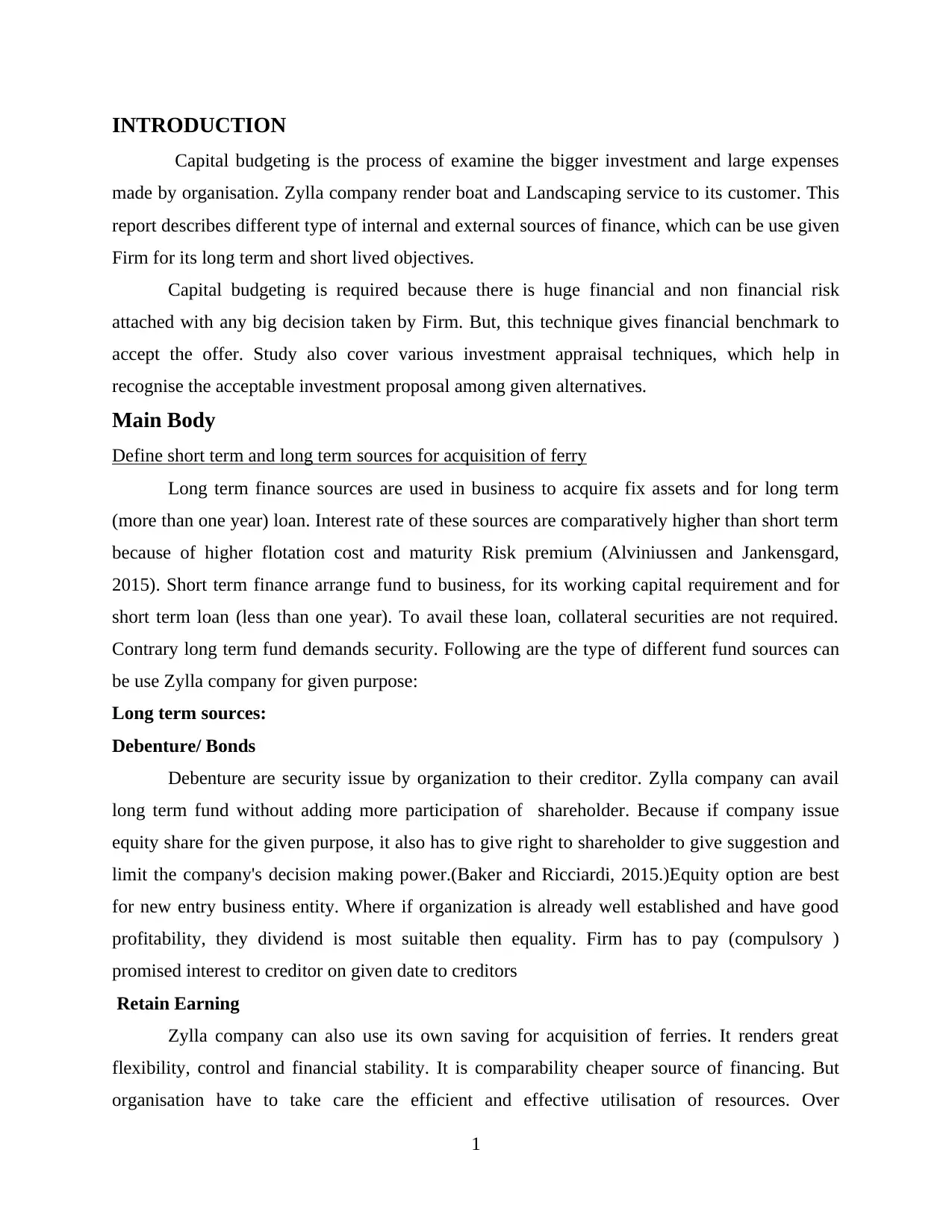
INTRODUCTION
Capital budgeting is the process of examine the bigger investment and large expenses
made by organisation. Zylla company render boat and Landscaping service to its customer. This
report describes different type of internal and external sources of finance, which can be use given
Firm for its long term and short lived objectives.
Capital budgeting is required because there is huge financial and non financial risk
attached with any big decision taken by Firm. But, this technique gives financial benchmark to
accept the offer. Study also cover various investment appraisal techniques, which help in
recognise the acceptable investment proposal among given alternatives.
Main Body
Define short term and long term sources for acquisition of ferry
Long term finance sources are used in business to acquire fix assets and for long term
(more than one year) loan. Interest rate of these sources are comparatively higher than short term
because of higher flotation cost and maturity Risk premium (Alviniussen and Jankensgard,
2015). Short term finance arrange fund to business, for its working capital requirement and for
short term loan (less than one year). To avail these loan, collateral securities are not required.
Contrary long term fund demands security. Following are the type of different fund sources can
be use Zylla company for given purpose:
Long term sources:
Debenture/ Bonds
Debenture are security issue by organization to their creditor. Zylla company can avail
long term fund without adding more participation of shareholder. Because if company issue
equity share for the given purpose, it also has to give right to shareholder to give suggestion and
limit the company's decision making power.(Baker and Ricciardi, 2015.)Equity option are best
for new entry business entity. Where if organization is already well established and have good
profitability, they dividend is most suitable then equality. Firm has to pay (compulsory )
promised interest to creditor on given date to creditors
Retain Earning
Zylla company can also use its own saving for acquisition of ferries. It renders great
flexibility, control and financial stability. It is comparability cheaper source of financing. But
organisation have to take care the efficient and effective utilisation of resources. Over
1
Capital budgeting is the process of examine the bigger investment and large expenses
made by organisation. Zylla company render boat and Landscaping service to its customer. This
report describes different type of internal and external sources of finance, which can be use given
Firm for its long term and short lived objectives.
Capital budgeting is required because there is huge financial and non financial risk
attached with any big decision taken by Firm. But, this technique gives financial benchmark to
accept the offer. Study also cover various investment appraisal techniques, which help in
recognise the acceptable investment proposal among given alternatives.
Main Body
Define short term and long term sources for acquisition of ferry
Long term finance sources are used in business to acquire fix assets and for long term
(more than one year) loan. Interest rate of these sources are comparatively higher than short term
because of higher flotation cost and maturity Risk premium (Alviniussen and Jankensgard,
2015). Short term finance arrange fund to business, for its working capital requirement and for
short term loan (less than one year). To avail these loan, collateral securities are not required.
Contrary long term fund demands security. Following are the type of different fund sources can
be use Zylla company for given purpose:
Long term sources:
Debenture/ Bonds
Debenture are security issue by organization to their creditor. Zylla company can avail
long term fund without adding more participation of shareholder. Because if company issue
equity share for the given purpose, it also has to give right to shareholder to give suggestion and
limit the company's decision making power.(Baker and Ricciardi, 2015.)Equity option are best
for new entry business entity. Where if organization is already well established and have good
profitability, they dividend is most suitable then equality. Firm has to pay (compulsory )
promised interest to creditor on given date to creditors
Retain Earning
Zylla company can also use its own saving for acquisition of ferries. It renders great
flexibility, control and financial stability. It is comparability cheaper source of financing. But
organisation have to take care the efficient and effective utilisation of resources. Over
1
⊘ This is a preview!⊘
Do you want full access?
Subscribe today to unlock all pages.

Trusted by 1+ million students worldwide
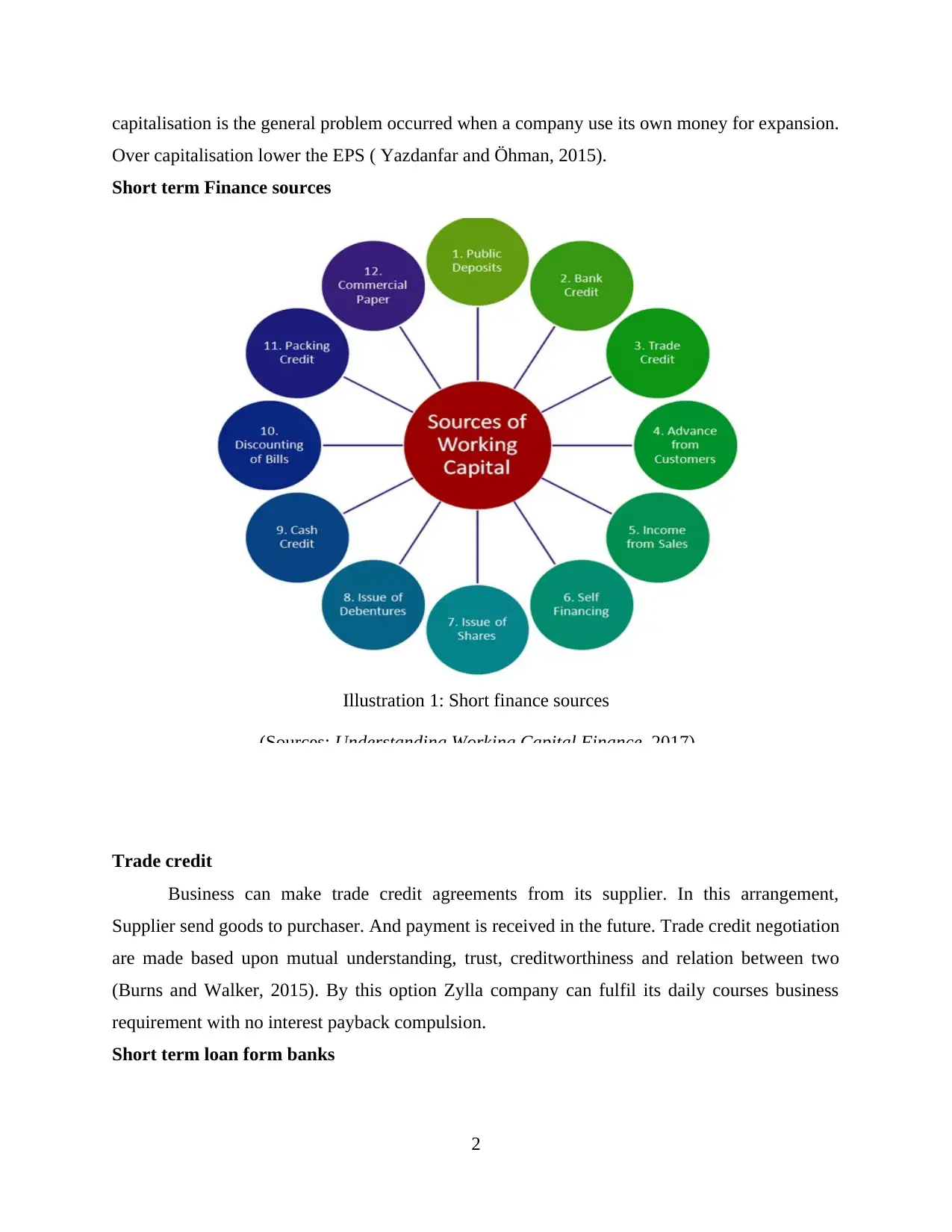
capitalisation is the general problem occurred when a company use its own money for expansion.
Over capitalisation lower the EPS ( Yazdanfar and Öhman, 2015).
Short term Finance sources
Trade credit
Business can make trade credit agreements from its supplier. In this arrangement,
Supplier send goods to purchaser. And payment is received in the future. Trade credit negotiation
are made based upon mutual understanding, trust, creditworthiness and relation between two
(Burns and Walker, 2015). By this option Zylla company can fulfil its daily courses business
requirement with no interest payback compulsion.
Short term loan form banks
2
Illustration 1: Short finance sources
(Sources: Understanding Working Capital Finance, 2017)
Over capitalisation lower the EPS ( Yazdanfar and Öhman, 2015).
Short term Finance sources
Trade credit
Business can make trade credit agreements from its supplier. In this arrangement,
Supplier send goods to purchaser. And payment is received in the future. Trade credit negotiation
are made based upon mutual understanding, trust, creditworthiness and relation between two
(Burns and Walker, 2015). By this option Zylla company can fulfil its daily courses business
requirement with no interest payback compulsion.
Short term loan form banks
2
Illustration 1: Short finance sources
(Sources: Understanding Working Capital Finance, 2017)
Paraphrase This Document
Need a fresh take? Get an instant paraphrase of this document with our AI Paraphraser
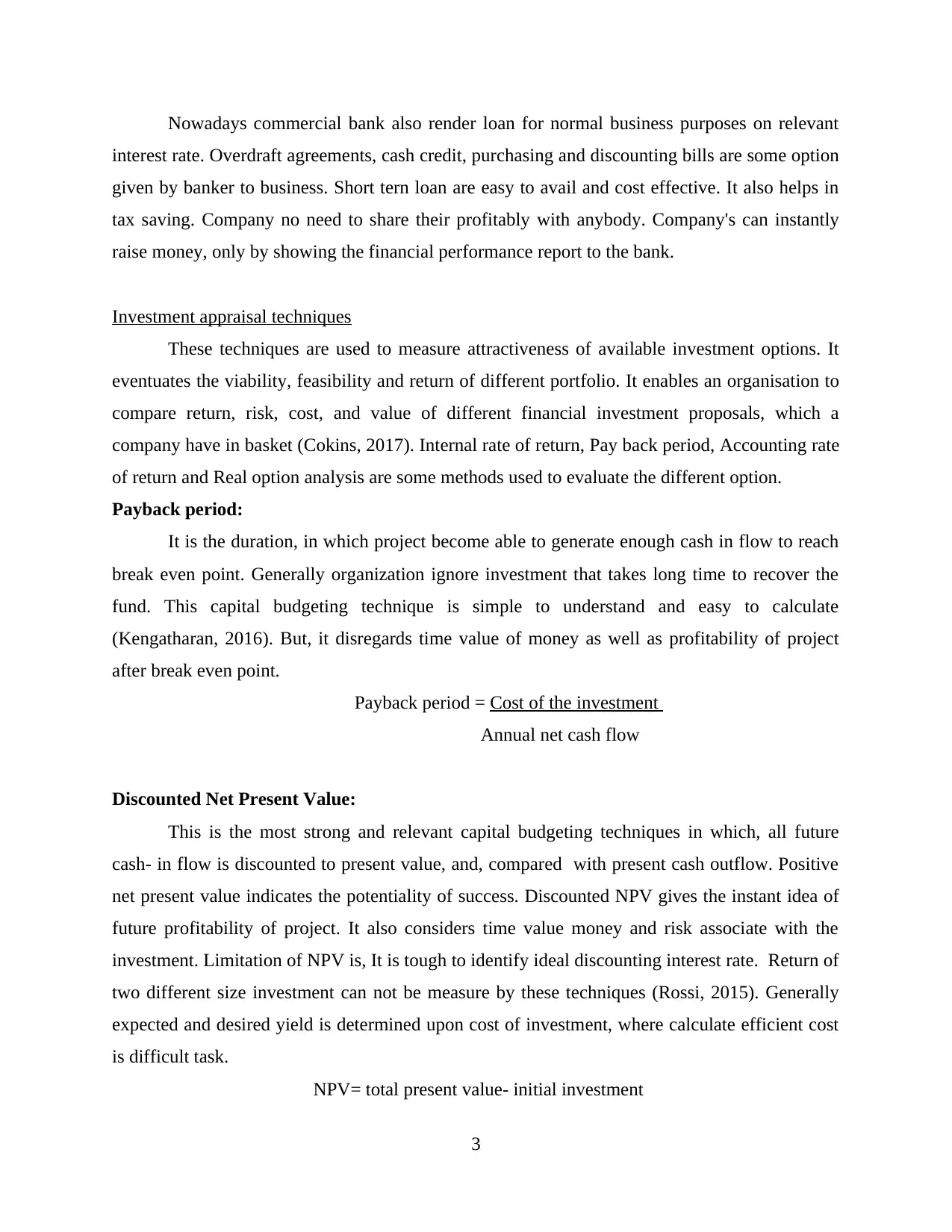
Nowadays commercial bank also render loan for normal business purposes on relevant
interest rate. Overdraft agreements, cash credit, purchasing and discounting bills are some option
given by banker to business. Short tern loan are easy to avail and cost effective. It also helps in
tax saving. Company no need to share their profitably with anybody. Company's can instantly
raise money, only by showing the financial performance report to the bank.
Investment appraisal techniques
These techniques are used to measure attractiveness of available investment options. It
eventuates the viability, feasibility and return of different portfolio. It enables an organisation to
compare return, risk, cost, and value of different financial investment proposals, which a
company have in basket (Cokins, 2017). Internal rate of return, Pay back period, Accounting rate
of return and Real option analysis are some methods used to evaluate the different option.
Payback period:
It is the duration, in which project become able to generate enough cash in flow to reach
break even point. Generally organization ignore investment that takes long time to recover the
fund. This capital budgeting technique is simple to understand and easy to calculate
(Kengatharan, 2016). But, it disregards time value of money as well as profitability of project
after break even point.
Payback period = Cost of the investment
Annual net cash flow
Discounted Net Present Value:
This is the most strong and relevant capital budgeting techniques in which, all future
cash- in flow is discounted to present value, and, compared with present cash outflow. Positive
net present value indicates the potentiality of success. Discounted NPV gives the instant idea of
future profitability of project. It also considers time value money and risk associate with the
investment. Limitation of NPV is, It is tough to identify ideal discounting interest rate. Return of
two different size investment can not be measure by these techniques (Rossi, 2015). Generally
expected and desired yield is determined upon cost of investment, where calculate efficient cost
is difficult task.
NPV= total present value- initial investment
3
interest rate. Overdraft agreements, cash credit, purchasing and discounting bills are some option
given by banker to business. Short tern loan are easy to avail and cost effective. It also helps in
tax saving. Company no need to share their profitably with anybody. Company's can instantly
raise money, only by showing the financial performance report to the bank.
Investment appraisal techniques
These techniques are used to measure attractiveness of available investment options. It
eventuates the viability, feasibility and return of different portfolio. It enables an organisation to
compare return, risk, cost, and value of different financial investment proposals, which a
company have in basket (Cokins, 2017). Internal rate of return, Pay back period, Accounting rate
of return and Real option analysis are some methods used to evaluate the different option.
Payback period:
It is the duration, in which project become able to generate enough cash in flow to reach
break even point. Generally organization ignore investment that takes long time to recover the
fund. This capital budgeting technique is simple to understand and easy to calculate
(Kengatharan, 2016). But, it disregards time value of money as well as profitability of project
after break even point.
Payback period = Cost of the investment
Annual net cash flow
Discounted Net Present Value:
This is the most strong and relevant capital budgeting techniques in which, all future
cash- in flow is discounted to present value, and, compared with present cash outflow. Positive
net present value indicates the potentiality of success. Discounted NPV gives the instant idea of
future profitability of project. It also considers time value money and risk associate with the
investment. Limitation of NPV is, It is tough to identify ideal discounting interest rate. Return of
two different size investment can not be measure by these techniques (Rossi, 2015). Generally
expected and desired yield is determined upon cost of investment, where calculate efficient cost
is difficult task.
NPV= total present value- initial investment
3
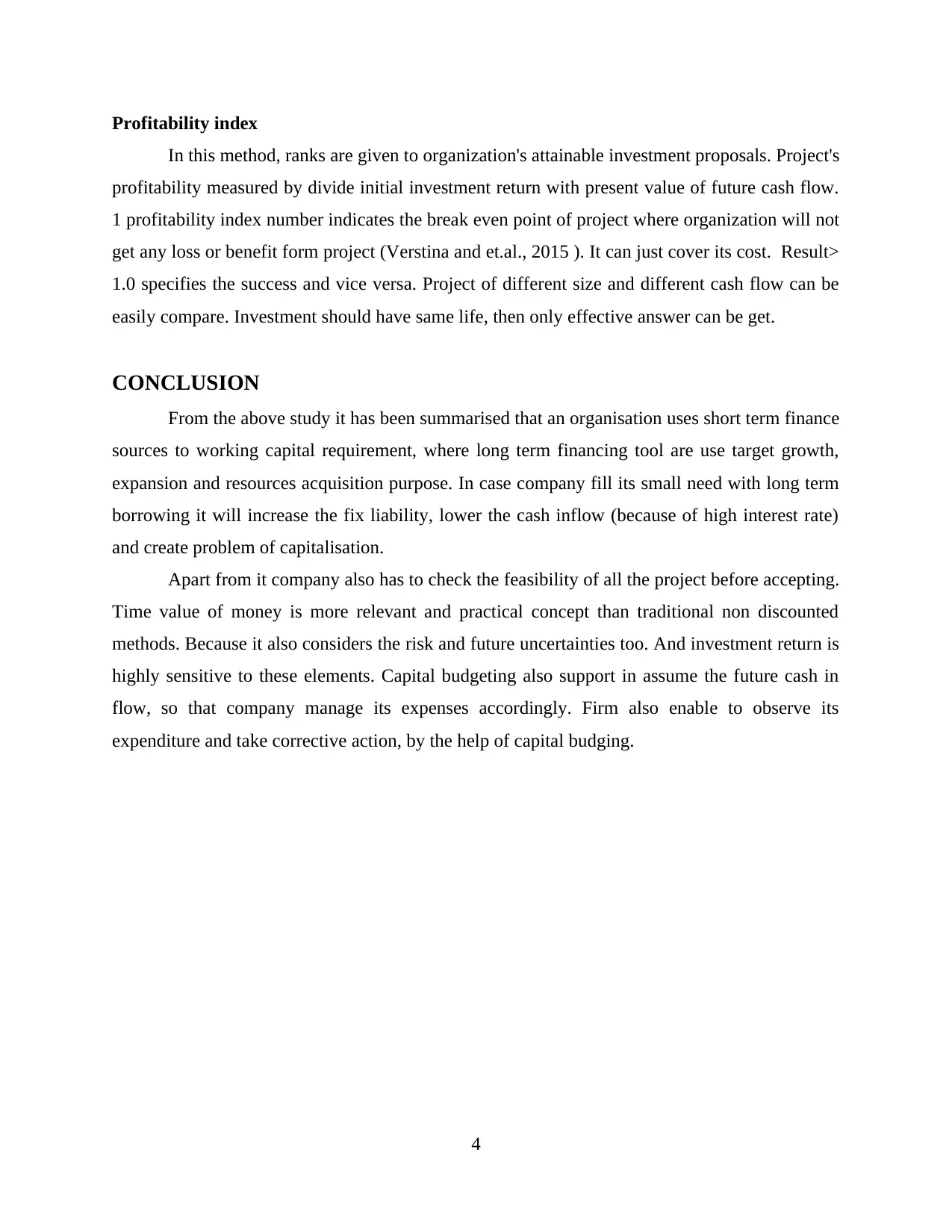
Profitability index
In this method, ranks are given to organization's attainable investment proposals. Project's
profitability measured by divide initial investment return with present value of future cash flow.
1 profitability index number indicates the break even point of project where organization will not
get any loss or benefit form project (Verstina and et.al., 2015 ). It can just cover its cost. Result>
1.0 specifies the success and vice versa. Project of different size and different cash flow can be
easily compare. Investment should have same life, then only effective answer can be get.
CONCLUSION
From the above study it has been summarised that an organisation uses short term finance
sources to working capital requirement, where long term financing tool are use target growth,
expansion and resources acquisition purpose. In case company fill its small need with long term
borrowing it will increase the fix liability, lower the cash inflow (because of high interest rate)
and create problem of capitalisation.
Apart from it company also has to check the feasibility of all the project before accepting.
Time value of money is more relevant and practical concept than traditional non discounted
methods. Because it also considers the risk and future uncertainties too. And investment return is
highly sensitive to these elements. Capital budgeting also support in assume the future cash in
flow, so that company manage its expenses accordingly. Firm also enable to observe its
expenditure and take corrective action, by the help of capital budging.
4
In this method, ranks are given to organization's attainable investment proposals. Project's
profitability measured by divide initial investment return with present value of future cash flow.
1 profitability index number indicates the break even point of project where organization will not
get any loss or benefit form project (Verstina and et.al., 2015 ). It can just cover its cost. Result>
1.0 specifies the success and vice versa. Project of different size and different cash flow can be
easily compare. Investment should have same life, then only effective answer can be get.
CONCLUSION
From the above study it has been summarised that an organisation uses short term finance
sources to working capital requirement, where long term financing tool are use target growth,
expansion and resources acquisition purpose. In case company fill its small need with long term
borrowing it will increase the fix liability, lower the cash inflow (because of high interest rate)
and create problem of capitalisation.
Apart from it company also has to check the feasibility of all the project before accepting.
Time value of money is more relevant and practical concept than traditional non discounted
methods. Because it also considers the risk and future uncertainties too. And investment return is
highly sensitive to these elements. Capital budgeting also support in assume the future cash in
flow, so that company manage its expenses accordingly. Firm also enable to observe its
expenditure and take corrective action, by the help of capital budging.
4
⊘ This is a preview!⊘
Do you want full access?
Subscribe today to unlock all pages.

Trusted by 1+ million students worldwide
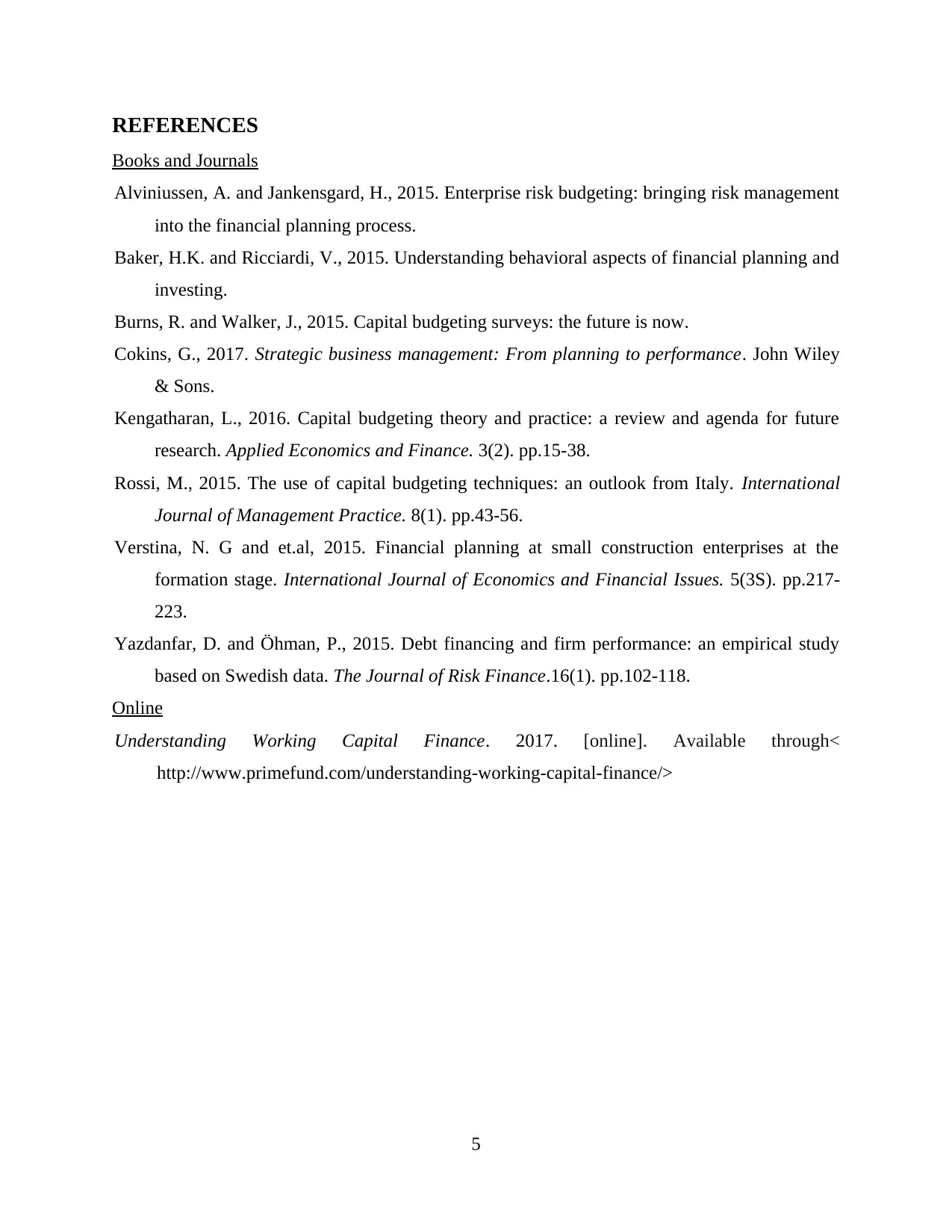
REFERENCES
Books and Journals
Alviniussen, A. and Jankensgard, H., 2015. Enterprise risk budgeting: bringing risk management
into the financial planning process.
Baker, H.K. and Ricciardi, V., 2015. Understanding behavioral aspects of financial planning and
investing.
Burns, R. and Walker, J., 2015. Capital budgeting surveys: the future is now.
Cokins, G., 2017. Strategic business management: From planning to performance. John Wiley
& Sons.
Kengatharan, L., 2016. Capital budgeting theory and practice: a review and agenda for future
research. Applied Economics and Finance. 3(2). pp.15-38.
Rossi, M., 2015. The use of capital budgeting techniques: an outlook from Italy. International
Journal of Management Practice. 8(1). pp.43-56.
Verstina, N. G and et.al, 2015. Financial planning at small construction enterprises at the
formation stage. International Journal of Economics and Financial Issues. 5(3S). pp.217-
223.
Yazdanfar, D. and Öhman, P., 2015. Debt financing and firm performance: an empirical study
based on Swedish data. The Journal of Risk Finance.16(1). pp.102-118.
Online
Understanding Working Capital Finance. 2017. [online]. Available through<
http://www.primefund.com/understanding-working-capital-finance/>
5
Books and Journals
Alviniussen, A. and Jankensgard, H., 2015. Enterprise risk budgeting: bringing risk management
into the financial planning process.
Baker, H.K. and Ricciardi, V., 2015. Understanding behavioral aspects of financial planning and
investing.
Burns, R. and Walker, J., 2015. Capital budgeting surveys: the future is now.
Cokins, G., 2017. Strategic business management: From planning to performance. John Wiley
& Sons.
Kengatharan, L., 2016. Capital budgeting theory and practice: a review and agenda for future
research. Applied Economics and Finance. 3(2). pp.15-38.
Rossi, M., 2015. The use of capital budgeting techniques: an outlook from Italy. International
Journal of Management Practice. 8(1). pp.43-56.
Verstina, N. G and et.al, 2015. Financial planning at small construction enterprises at the
formation stage. International Journal of Economics and Financial Issues. 5(3S). pp.217-
223.
Yazdanfar, D. and Öhman, P., 2015. Debt financing and firm performance: an empirical study
based on Swedish data. The Journal of Risk Finance.16(1). pp.102-118.
Online
Understanding Working Capital Finance. 2017. [online]. Available through<
http://www.primefund.com/understanding-working-capital-finance/>
5
1 out of 7
Related Documents
Your All-in-One AI-Powered Toolkit for Academic Success.
+13062052269
info@desklib.com
Available 24*7 on WhatsApp / Email
![[object Object]](/_next/static/media/star-bottom.7253800d.svg)
Unlock your academic potential
Copyright © 2020–2025 A2Z Services. All Rights Reserved. Developed and managed by ZUCOL.




